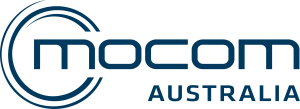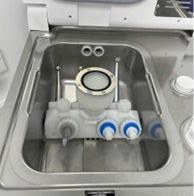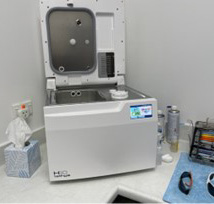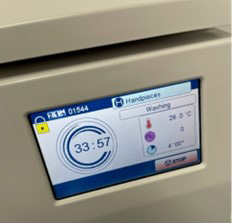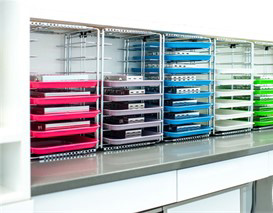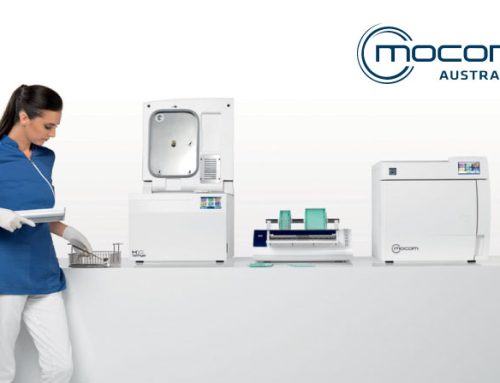As a dentist running a two-surgery practice, efficiency and productivity are paramount to providing quality patient care. Seven years ago, I invested in a Tethys Washer Disinfector from Henry Schein Dental, and it has truly revolutionised our sterilisation processes with its automated approach.
One of the standout features of the Tethys is its ability to free up my staff’s valuable time, allowing them to focus on other essential tasks. With the unit’s efficient cleaning and disinfection capabilities, my dental assistant can rely on it to handle instrument reprocessing effortlessly, ensuring optimal hygiene standards are met.
The unit is very easy to use. The controls are simple and intuitive, and the cycle options are clearly labelled. Using instrument cassettes further enhances the convenience and efficiency of the Tethys Washer Disinfector. Not only does this simplify the loading and unloading process, but it also ensures consistent and thorough cleaning of dental instruments. This streamlined approach eliminates the need for manual cleaning, saving both time and effort for my team.
Additionally, the Tethys drying cycle is an important feature for us. Its effective drying capabilities eliminate the need for manual drying, allowing my dental assistant to move the dried instruments straight to the steriliser, maximising workflow efficiency. This not only saves time but also reduces the risk of moisturerelated issues during the sterilisation process. I am currently reviewing the Tethys Handpiece Accessory which is designed to complement the Tethys Washer Disinfector, offering a solution to the internal and external cleaning of dental handpieces. The accessory’s high-level disinfection cycle eliminates potential pathogens, providing an added layer of safety for our patients and staff.
The tank size of the Tethys could be a challenge to bigger practices that use more instruments, however, its quick cycle time ensures that dirty instruments are processed and disinfected within 35 – 45 minutes depending on what cycle is used. For us, there is no hold-up or wait time for instruments. Should there be a delay in the reprocessing workflow, then it is more important to have disinfected instruments waiting for the steriliser, rather than dirty drying instruments waiting to be cleaned. The unit cleans instruments well and they come out shiny. On the odd occasion, a grossly soiled fluted bur may require reprocessing.
Over the past seven years, I have had no issues with the Tethys Washer Disinfector. Its reliable performance has consistently met our practice’s needs, providing peace of mind that our instruments are consistently cleaned and disinfected to the highest standards. In conclusion, the Tethys has been an invaluable addition to our practice. Its ability to streamline our sterilisation processes, reduce manual labour, and ensure optimal instrument hygiene, has improved our overall efficiency. I highly recommend this unit to fellow dental professionals looking to enhance their practice’s productivity and maintain best-practice sterilisation protocols.

The procedures required to prepare a contaminated reusable device ready for its intended use involve several steps. Known as instrument reprocessing, these steps follow an orderly flow from cleaning through to sterilisation and storage.
In our ‘Steps into Steri’ series, we have discussed Step 1 – receiving, cleaning, and decontamination, Step 2 – Preparation and Packaging, and Step 3 – Sterilisation. In this fourth and last instalment of our Steps into Steri series, we proceed to Step 4 – Storage, to explore the key considerations and best practices for instrument storage.
Proper storage of processed instruments plays a critical role in maintaining their sterility and ensuring their quality for patient treatment. The shelf life of sterilised items is not solely determined by time, but is influenced by storage conditions such as temperature, ventilation, and humidity. So rather than time, a concept called ‘Event-Related Shelf Life’ is commonly used in healthcare settings to determine the expiration date or recommended storage duration for sterilised instruments.
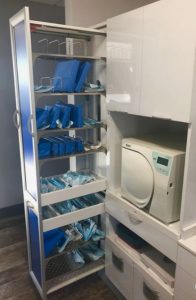
The term ‘event-related’ signifies that the shelf life is related to specific events or factors that may compromise the sterility of the instruments, therefore, affecting the length of time that they remain sterile and suitable for use. These events can include the packaging integrity being compromised, the instrument packs being exposed to excessive humidity, temperature fluctuations, or similar conditions that could potentially impact their sterility. By employing event-related shelf life, dental practices can ensure that sterilised instruments are stored properly and remain sterile until they are needed for a procedure.

Regular monitoring, inspection, and quality assurance processes are typically put in place to assess the instruments and make informed decisions regarding their usability and storage duration. Critical items must maintain their sterility until the point of use. Sterilised semi-critical items and noncritical items must be protected from contamination before re-use. Store items in a clean, dry, dust-free environment outside the contaminated zone. Splashes of fluids and aerosols produced during clinical treatment or instrument reprocessing pose significant risks. Moisture, whether from wet surfaces or splashes with water and other liquids, can lead to contamination. To prevent packs from being placed on a wet benchtop use Aquasorb Lint Free Cloths. These thick, super-absorbent microfibre cloths will absorb 315% of their own weight without dripping.
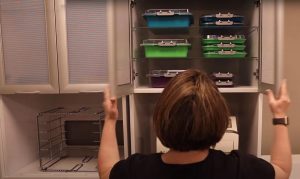
Storage areas with dedicated drawers or cupboards for wrapped sterilised instruments will provide added protection against environmental contamination. Transparent doors or locating the stored items at an appropriate height facilitates easy visibility. The storage area should be adequately sized to prevent the items from being densely packed together, as overcrowding increases the likelihood of packaging integrity being compromised. High humidity should also be avoided, as it can lead to dampness-related issues. Keeping sterilised instruments in sealed tubs (ZC-20Z459 & ZC-20Z463D) helps minimize the risk of contamination.
If open shelves or racks are used for storage, items must be positioned at least 250 mm above the floor and 400 mm away from ceiling fixtures. The Zirc tub and tray rack can save on counter space as several tubs or trays with covers can fit into one rack. The covers will protect items from dust accumulation. The racks may also be used to store instrument cassettes.
Areas used for instrument storage require periodic cleaning as part of the environmental cleaning process. Surface management can be achieved with a clinical detergent like Majac’s ProDet to help maintain a contaminant-free environment for your stored instruments.
About Asiga
Asiga 3D printers offer an open material architecture providing compatibility with more than 500 materials from many industry leading 3D printing polymer manufacturers.
About Dr Kasen Somana
Dr Kasen Somana has been in private practice in Melbourne, Australia for almost 20 years and is the principal dentist of Signature Dentistry in Toorak. His practice has a special interest in conservative digital aesthetic fixed prosthodontics and occlusal rehabilitation. Determined to provide the highest level of care to his patients, he often participates and lectures at digital dental conferences locally and internationally. He is a key opinion leader for 3Shape and Asiga.

BSc Hons (Melb) BDS Hons (Syd) MSc (Lond) MFGDP (UK)
Reference
ADA, https://www.ada.org.au/Dental-Professionals/Publications/Infection-Control/Guidelines-for-Infection-Control/Guidelines-for-Infection-Control-V4.aspx Dental Council, https://www.dcnz.org.nz/assets/Uploads/Consultations/2015/Infectionprevention-and-control-practice-standard-effective1May16.pd The products listed are provided as suggestions only.
Are you thinking about setting up a new Dental Practice or renovating and redesigning your existing clinic? Check out Henry Schein’s Surgery Setup website for a range of resources and information to help you get sorted.
Be sure to keep an eye on Henry Schein’s Dental Education Hub for related events, courses, and information.
